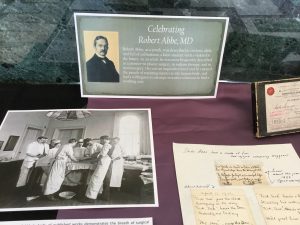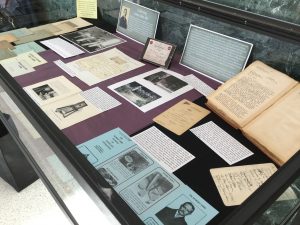 A new exhibit is now on display in the Mount Sinai West hospital lobby. Celebrating Robert Abbe, MD aims to share the many sides of Dr. Robert Abbe: the medical pioneer, the innovator, the artist, and the collector.
A new exhibit is now on display in the Mount Sinai West hospital lobby. Celebrating Robert Abbe, MD aims to share the many sides of Dr. Robert Abbe: the medical pioneer, the innovator, the artist, and the collector.
A native son of New York, Robert Abbe was born on April 13, 1851 and raised on Dutch Street in lower Manhattan. He attended public schools and took evening classes at the Cooper Union for the Advancement of Science and Art to develop his talents for drawing and painting. He earned an undergraduate degree from the College of the City of New York in 1870 and joined the faculty there after graduation, teaching Drawing, Geometry, and English. He completed an MD degree in 1874 from the College of Physicians and Surgeons, and spent his residency at St. Luke’s Hospital. He later became an Attending Surgeon there, as well as Roosevelt Hospital (now Mount Sinai West), the Cancer Hospital, New York Babies Hospital, Ruptured and Crippled (today’s Hospital for Special Surgery), and Woman’s Hospital.
As a youth, Robert Abbe was described as curious, alert, and full of enthusiasm, a keen student with a vision for the future. As an adult, he was most frequently described as a pioneer – in plastic surgery, in radium therapy, and in neurosurgery. His was an inquisitive mind and he enjoyed the puzzle of repairing injuries to the human body, and had a willingness to attempt inventive solutions to find a working cure.
On view in the exhibit is a small sampling of published articles by Abbe documenting the broad variety of surgeries he performed, including neurosurgery, treatments for various problems of the hand, gallbladder, and cancer of the cheek, jaw, and breast. Later in his career, he wrote on the use of radium in the treatment of various conditions.
Abbe continued to exercise his artistic talents into adulthood, not only as a fine plastic surgeon, but also as a painter. Ever curious to try new things, when the Lumiere brothers of France developed a new method for taking color photos using a glass plate and various salts in 1905, Abbe was quite interested. By 1907 it was available in the US, and Abbe was among the first to experiment with the method by photographing family and friends, producing some lovely images that have a delicate and painting-like appearance. Two of these images are on display in the lobby case.
Another of Abbe’s amusements was collecting documents and photographs of or about famous medical persons. He created scrapbooks on such notables as Louis Pasteur, Benjamin Rush, Edward Jenner, Joseph Lister, and Marie Curie. He also acquired several objects of these notables. Between 1911 and 1923 he donated this collection to the College of Physicians in Philadelphia. On display in the exhibit is a photograph of Marie Curie in her laboratory, and another of the quartz-piezo-electro meter, which she used to determine the strength of electron discharge from radium. In 1921, at Abbe’s prompting, she donated it to the “Abbe Cabinet,” as his collection is called, at the College of Physicians, where it remains on display.
The high esteem in which Abbe was held is documented by his 70th birthday celebrations, which were held at the New York Yacht Club and attended by many friends and relations coming together for a dinner in his honor. On display are two dinner menus for the evening, one of which was autographed on the back by several well-known physicians in attendance. Along with the menu is a bound volume of typed copies of letters he received on the happy occasion conveying best wishes and fond remembrances from colleagues, friends, staff, and former students from around the country. The book is opened to a letter from William J. Mayo, MD of the Mayo Clinic, who was among his students.
During his later years Abbe spent summers in Bar Harbor, Maine where he developed an interest in the Native American population of the area. He began collecting Native American tools and Stone Age artifacts he found. He dreamt of creating a museum to display his extensive collection, raised funds to do so and designed many of the exhibits himself. The museum opened only five months after his passing in 1928. A pamphlet from the museum is included in the exhibit.
 Please stop into the lobby at Mount Sinai West and browse the display, which is on view through October.
Please stop into the lobby at Mount Sinai West and browse the display, which is on view through October.
